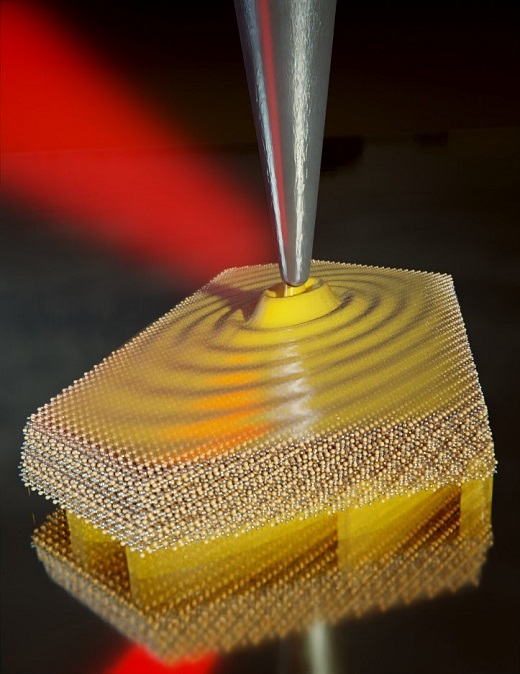by Elhuyar Fundazioa

Artistic illustration of in-plane elliptical acoustic THz plasmon polaritons propagating along a thin Ag2Te platelet above an Au mirror, excited and probed by a sharp THz-illuminated metal tip Credit: Scixel / CIC nanoGUNE
An international team of scientists has imaged and analyzed THz waves that propagate in the form of plasmon polaritons along thin anisotropic semiconductor platelets with wavelengths reduced by up to 65 times compared to THz waves in free space.
What's even more intriguing is that the wavelengths vary with the direction of propagation. Such THz waves can be applied for probing fundamental material properties at the nanometer scale and pave the way to the development of ultra-compact on-chip THz devices. The work has been published in Nature Materials.
Polaritons are hybrid states of light and matter that arise from the coupling of light with matter excitations. Plasmon and phonon polaritons are among the most prominent examples, formed by the coupling of light to collective electron oscillations and crystal lattice vibrations, respectively.
They play a crucial role in various applications, from sub-diffraction optical spectroscopy and ultrasensitive chemical sensors to ultracompact modulators for communication applications. In thin layers, polaritons can propagate with wavelengths up to 100 times shorter than the corresponding photon wavelength, allowing for manipulation of light on a much smaller scale than previously possible with conventional photonic devices.
While most of these ultra-confined polaritons have been observed in form of phonon polaritons in the mid-infrared spectral range, the researchers focused on plasmon polaritons, as these can exist in much broader spectral ranges. "On the other hand, plasmon polaritons often suffer from large damping, resulting in short propagation lengths. This has been challenging the observation of ultra-confined plasmon polaritons in real space," says Shu Chen, first author of the publication.
Using a THz nanoscope (more precisely, a THz scattering-type scanning near-field optical microscope, s-SNOM) in Rainer Hillenbrand´s lab at CIC nanoGUNE (San Sebastian, Spain), Chen studied thin platelets of the low-symmetry crystal silver telluride (Ag2Te; hessite) and obtained the first real-space images of THz plasmon polaritons, whose wavelengths are up to 65 times reduced compared to the photon wavelength and vary with the propagation direction.
"Silver telluride is a narrow bandgap semiconductor with a relatively high mobile electron concentration, which makes this material plasmonic at THz frequencies," says Pengliang Leng, equally contributing first author, who fabricated the platelets in Faxian Xiu´s lab at Fudan University (Shanghai, China). "Because of the low-symmetry monoclinic crystal structure, the effective electron mass is strongly anisotropic along the platelet surface, which explains the anisotropic plasmon polariton propagation," adds Faxian Xiu.
The researchers also demonstrated that the relative propagation lengths of the THz polaritons can be significantly increased by coupling them with their mirror image in an adjacent metal substrate. "Because of this coupling, so-called acoustic plasmon polaritons are formed," explains Andrea KonečnĻĒ from Brno University (Czech Republic), who theoretically modeled the acoustic polaritons.
"Most important, the anisotropy of the polariton propagation is qualitatively preserved, and the long relative propagation lengths allowed us to unambiguously verify that the polaritons propagate with elliptical wavefronts," adds Rainer Hillenbrand from nanoGUNE, who led the work.
The long relative propagation lengths of the elliptical acoustic plasmon polaritons finally allowed the researchers to determine the in-plane anisotropic effective electron mass, establishing a unique method for the nanoscale measurement of directional effective carrier masses at room temperature.
Beyond exploring fundamental materials properties in conventional and novel quantum materials, ultra-confined in-plane anisotropic acoustic plasmon polaritons may lead to ultra-compact on-chip THz applications. The strong field concentration in the gap between the polaritonic layer and metal surface may be exploited for field-enhanced molecular sensing or for boosting (ultra)strong THz lightĻCmatter coupling with molecules, classical 2D electron gases or quantum materials.

